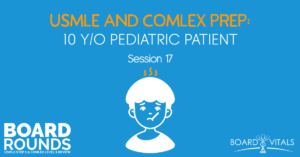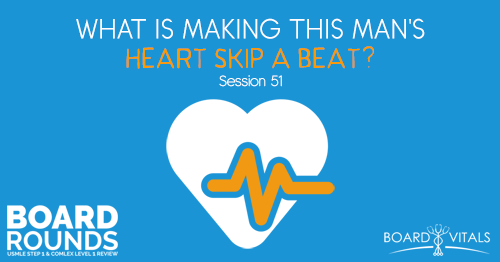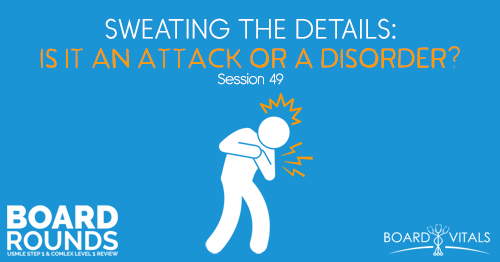Apple Podcasts | Google Podcasts

Session 17
Dr. Karen Shackelford from BoardVitals is joining me once again for another round of discussion. This week, we tackle a certain kind of pediatric illness.
[01:11] Question of the Week:
A 10-year-old male patient is evaluated for abdominal pain he has had for two days. He has a rash on his buttocks and thighs. It appeared about three days ago.
He’s also complaining of some pain in his ankles and knees. His past medical history is unremarkable. But he was seen in the clinic two weeks ago with symptoms of an upper respiratory infection.
On physical exam, his abdomen has standard palpation. 01:42 He has multiple palpable purpuras on his buttocks and upper thighs. 01:50 His ankle is swollen and tender on the right. There’s no warrant for eczema. His knee is tender.
But otherwise, his exam was unremarkable. His laboratory study is showing a normal CBC. On urine 02:09, he has microhematuria.
What is the most likely diagnosis?
(A) IgA vasculitis (formerly Purpura)
(B) Hemolytic uremic syndrome
(C) Kawasaki disease
(D) Acute post-streptococcal glomerulonephritis
[03:40] Thought Process
The correct answer here is IgA vasculitis. The palpable purpura on the buttocks and lower extremities is one of the criteria you have to have for purpura, without thrombocytopenia.
The other symptoms this patient has, where you could have one or all of these other symptoms, including polyarthralgia, usually in the hip, ankle, and/or knee joints.
GI symptoms include abdominal pain, nausea, vomiting, 05:26 or intussusception. Thi has renal involvement, without thrombocytopenia or coagulopathy. These are the two big things.
As mentioned, the CBC was normal and he did have the proliferative glomerulonephritis, which occurs with the IgA deposition in the glomeruli.
Leukocytoclastic vasculitis is characterized by leukocytes. Neutrophils or monocytes are around the small vessels – the arterioles and venules. There’s IgA deposition. There can be IgG or IgM. There is complement C through a deposition. This is what you would see in a biopsy.
The lesions are generally in the GI tract or in the skin (which are typically the ones that are biopsied). But if the patient does develop the glomerulonephritis, renal biopsy will show that. That doesn’t develop in every case.
The disorder is self-limited so treatment-supportive. It’s an immune complex seen usually after an upper respiratory infection.
In one case series, it has been associated with the MMR vaccine, although this might not have been held up in the later studies.
This is also common between the ages of 3 and 11. One of the diagnostic criteria is that the patient has to be under 20.
[07:35] Going Through Other Answer Choices
In hemolytic uremic syndrome, you can have 07:41 purpura, although they’re non-palpable and they’re palpable in an 07:49 purpura. That occurs in hemolytic uremic syndrome due to thrombocytopenia. And this patient has a normal CBC.
Hemolytic uremic syndrome is usually associated with E.coli infection in the previous case of diarrhea. But there’s no history of that in the patient.
There is abdominal pain but the rash is not limited to the lower extremities and buttocks. That is characteristic of HSP IgA vasculitis.
Kawasaki disease usually occurs in children under the age of 4. The case will usually present a child of Asian descent. It’s more prevalent in Japanese children who are at a high risk of IVIG resistance.
They will generally have conjunctivitis and fever for more than 5 days. They have that strawberry tongue. The skin manifestations are non-palpable purpura, but there are periungual desquamation and hand-and-foot erythema.
Acute post-streptococcal glomerulonephritis can present with hematuria. It can occur after a skin infection or a pharyngeal infection. That was meant to be with a rash. Maybe someone will consider this because there’s a rash involved.
As group-A beta-hemolytic strep, this patient had a previous upper respiratory infection which could potentially have been caused by strep. But arthralgia isn’t common. Abdominal pain isn’t common. And the purpura also not associated with acute post-streptococcal glomerulonephritis.
[11:10] BoardVitals
If you’re looking for a QBank in preparing for your board, check out BoardVitals. They have over 1700 questions for Step 1 and over 1500 questions for Level 1 with detailed explanations behind every question and every answer.
Use the promo code BOARDROUNDS to save 15% off.
Links:
BoardVitals (promo code BOARDROUNDS to save 15% off)
SEARCH SITE
LISTEN FOR FREE











